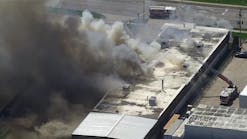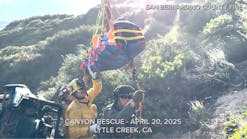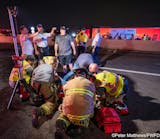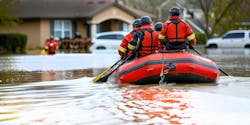Portable containers are regulated by the U.S. Department of Transportation (DOT) in transportation and governed by ASME, National Fire Protection Association (NFPA) and Occupational Safety and Health Administration (OSHA) standards in fixed storage and use. However, a portable container can be made of any material that will hold the contents. In some cases, containers may be reused from some other purpose, which may create an unsafe storage condition.
Portable containers include, but are not limited to the following types: wooden and fiberboard boxes, metal drums, fiberboard drums, plastic pails, glass carboys in protective containers, cylinders, ton cylinders, mailing tubes, lead containers for radioactive materials, plastic and multi-wall paper bags. Liquid quantities can range from a few ounces to several hundred gallons. Dry materials may range from a few ounces to several hundred pounds. Gases generally do not have much weight, but require a substantial container to hold the high pressures, causing the tank to be very heavy.
Fiberboard drums and multi-wall paper bags are used for dry materials such as ammonium nitrate fertilizer and calcium hypochlorite, both of which are oxidizers. If the containers become wet during transportation or storage, or during firefighting operations, the packaging material can become impregnated with the oxidizer once the moisture evaporates. If the packaging materials are then exposed to heat or flame in a fire, they can burn vigorously because of the oxidizer imbedded in the container material.
Glass and plastic carboys as well as stainless steel kegs, 55-gallon drums, pint and gallon glass bottles, five-gallon plastic pails and lined drums are used to transport and store many acids and bases and a variety of other hazardous materials. Acids can react quickly with a container, causing container failure and subsequent spill of material if incompatible construction materials are used. Not all acids and bases can be placed in the same types of containers. Damage can occur to a container if different acids or bases are mixed in a container.
Plastic and glass bottles, 55-gallon drums, and plastic and metal pails may also be used for flammable, poisonous or oxidizing liquids. Glass and plastic bottles placed inside lead containers are used for some radioactive isotopes. More substantial lead containers are used for high-level radioactive materials because of the shielding required to keep the radioactivity from leaving the container.
Portable container pressures range from atmospheric in the case of drums and bags to ultra-high pressures of 6,000 psi for cylinders. Nearly every type of hazardous material found in bulk quantities may also be found in small portable containers. Additionally, many hazardous materials are not shipped or stored in bulk quantities, but are usually found in small containers. Ammonium nitrate, dynamite, blasting caps, detonation cord, fireworks and other explosives are packaged and shipped in cardboard boxes.
Quantities of hazardous materials in portable containers are sometimes so small that the DOT does not consider them a serious hazard and does not require placarding or labeling. These materials are placed in a special class known as Other Regulated Materials (ORM-D). For example, charcoal lighter would be classified as a flammable liquid in bulk quantities; however, in quart cans for consumer use it is an ORM-D. Large numbers of small containers in a shipment or in fixed storage collectively can create a serious hazard, even though the individual container quantity is small.
Cryogenic Materials
Cryogenic hazardous materials (those with boiling points below -130 degrees Fahrenheit) are shipped, stored and used in two types of portable containers: Dewar and cylinder. Dewar containers are non-pressurized vacuum-jacketed flasks with a five- to 20-liter capacity, very much like a Thermos bottle. Cylinder containers are insulated with separate vacuum-jackets and 100- to 200-liter capacities.
Cryogenic containers are usually found at gas-bottling plants, college and university research facilities, private-sector research facilities and are replacing the oxygen gas cylinder in welding operations in many areas. Common cryogenic hazardous materials include oxygen, nitrogen, argon, hydrogen, natural gas, helium and others. Cryogenic liquids have very low boiling points and high liquid-to-vapor expansion ratios. Even a small Dewar or cylinder could produce a significant vapor cloud during a release, causing the displacement of oxygen in confined areas.
While many of the cryogenic liquids are "inert," or non-hazardous, the vapor can still be an asphyxiation hazard when the oxygen in the air is displaced. In addition, the contents of cryogenic containers are extremely cold with temperatures between -130F and -456F. Contact with these liquids could cause frostbite or solidification of body parts, or both.
Cryogenic liquids and liquefied gases such as propane and butane do not have the same physical characteristics. While cryogenics are very cold, liquefied gases exist at whatever ambient temperature is surrounding the container - if the ambient temperature is 100F, then the liquefied gas is also around 100F.
Portable tanks of liquefied compressed gases can be found in many sizes and shapes. They can contain many types of gases, but commonly contain propane or other liquefied petroleum gas (LPG) used for home barbecue grills, heating living spaces, as a fuel for motorized equipment, soldering and others.
These containers shouldn't be overfilled. There should be a vapor space when the container is filled, usually around 20% of the volume of the container, to allow for expansion of gas within the container during increases in ambient temperature. While not as extensive as cryogenic liquids, liquefied petroleum gases also have large liquid-to-gas expansion ratios in the area of 270 to 1, so even a small container can produce a large amount of flammable gas when released to the atmosphere.
Pressures in LPG containers can range from 15 to 230 psi, depending on the ambient temperature. The higher the temperature outside the container, the higher the pressure inside the container will be. Container bursting pressures are generally about four times greater than the working pressures of LPG. Rapid heat buildup can still cause container rupture if the pressure cannot be relieved fast enough.
Liquefied petroleum gases are heavier than air and are found in basements or other low-lying areas during a release. They have no natural odor and are colorless. An odorizer is added to allow leaks to be detected.
Compressed gas cylinders are also common and often used for oxygen, nitrogen, carbon dioxide, fire extinguishing agents, hydrogen and many others. These containers are made of heavy steel and have operating pressures of 3,000 to 6,000 psi. Just the pressure alone in the container can present a significant physical hazard if the valves are knocked off or the containers are exposed to high heat or direct flame contact. These containers can rocket a great distance and present an impact hazard to building occupants and response personnel.
Safety Measures
A cylinder in storage should have a protective valve cap in place over the valve and be secured in place or to a cart. Exposed valves can be sheared off if a cylinder is knocked over. Cylinders in use should also be secured in place. Cylinders should never be moved or transported with the regulator in place; it should be replaced with the protective valve cap. Fire code inspectors should watch for the proper storage and use of high-pressure cylinders during inspections. While many compressed gas cylinders are painted, there is no reliable color code system to identify the contents from the color of the container.
Ton containers (2,000-pound capacity) are used most often for storing chlorine and sulfur dioxide gases. They are also used to store military blister agents. These cylinders can be found in water-treatment facilities, waste-treatment plants and swimming pools. They are shipped on specially equipped rail and highway vehicles.
Acetylene is a common flammable gas usually associated with welding operations in conjunction with gaseous or cryogenic oxygen. Acetylene is a highly flammable gas with a wide flammable range (2-80%), which is quite unstable at elevated pressures above 15 psi. The acetylene tank is a small "chunky" tank specially constructed to contain this highly unstable gas. An inert material such as fullers earth or lime silica is placed in the acetylene container to absorb acetone, a solvent used to dissolve the acetylene gas and maintain its stability. The acetone keeps the acetylene in suspension preventing accumulation of pockets of high-pressure gas thus stabilizing the explosive tendencies of the gas. An acetylene tank should never be stored or transported on its side, as the acetylene gas can separate from the acetone and produce a potentially explosive situation.
Because of their relatively small size, portable containers can be found in almost any type of transportation mode including private vehicles. They can also be found in most types of occupancies including residences and garages. The quantities of materials present don't create a high level of risk to the community. However, they certainly can be a hazard to response personnel, especially if we are not looking out for them.
Robert Burke, a Firehouse® contributing editor, is the fire marshal for the University of Maryland. He is a certified Hazardous Materials Specialist, and has served on state and county hazmat response teams. Burke is a veteran of over 18 years in the fire service, in career and volunteer fire departments, having attained the ranks of lieutenant and assistant chief, and served as deputy state fire marshal. He has an associate's degree in fire protection technology and a bachelor's degree in fire science, and is pursuing a master's degree in public administration. Burke is an adjunct instructor at the National Fire Academy. He is the author of the books Hazardous Materials Chemistry For Emergency Responders, published in 1997, and Counter-Terrorism For Emergency Responders, published in 1999. Burke can be reached on the Internet at [email protected].







